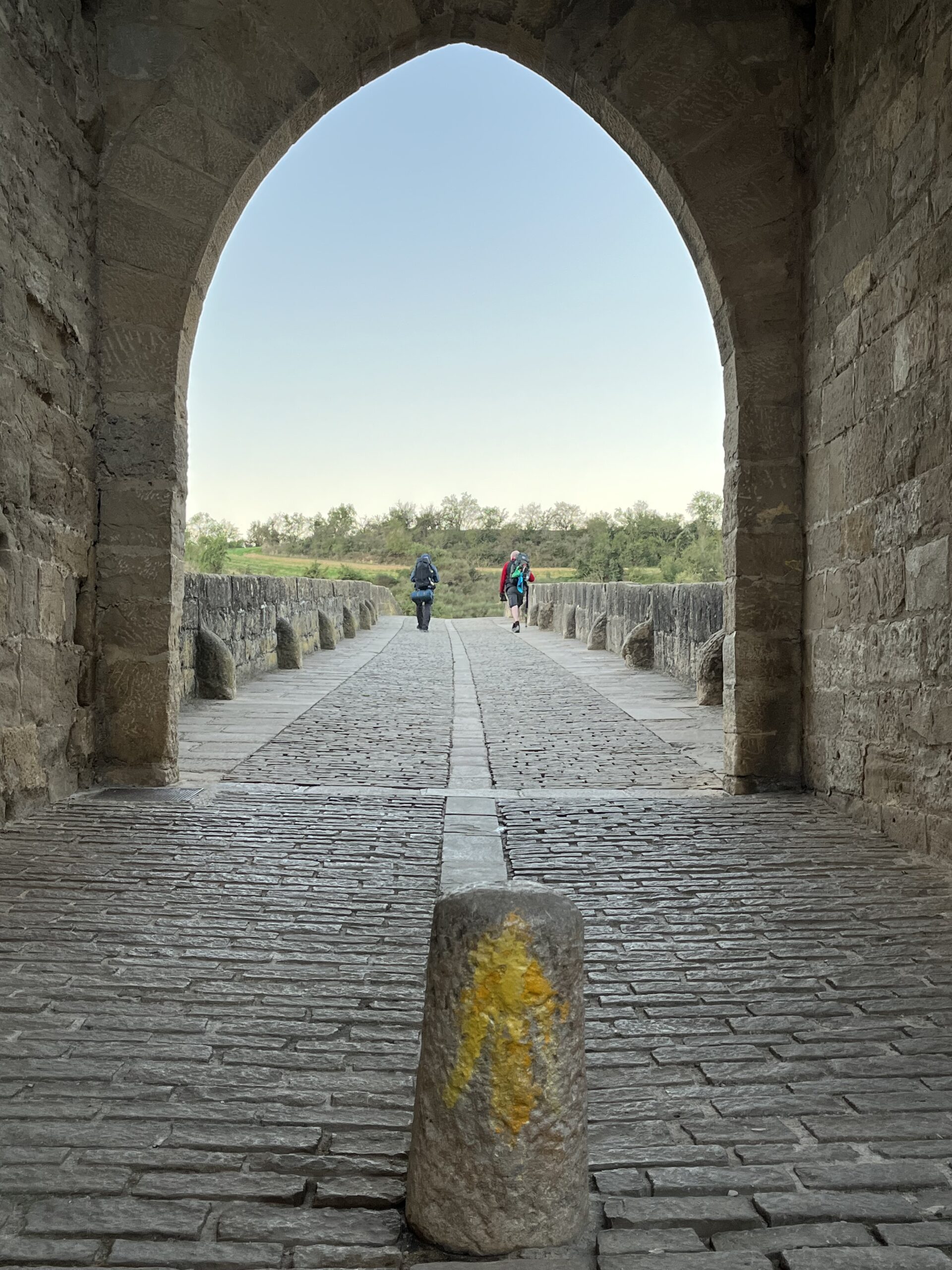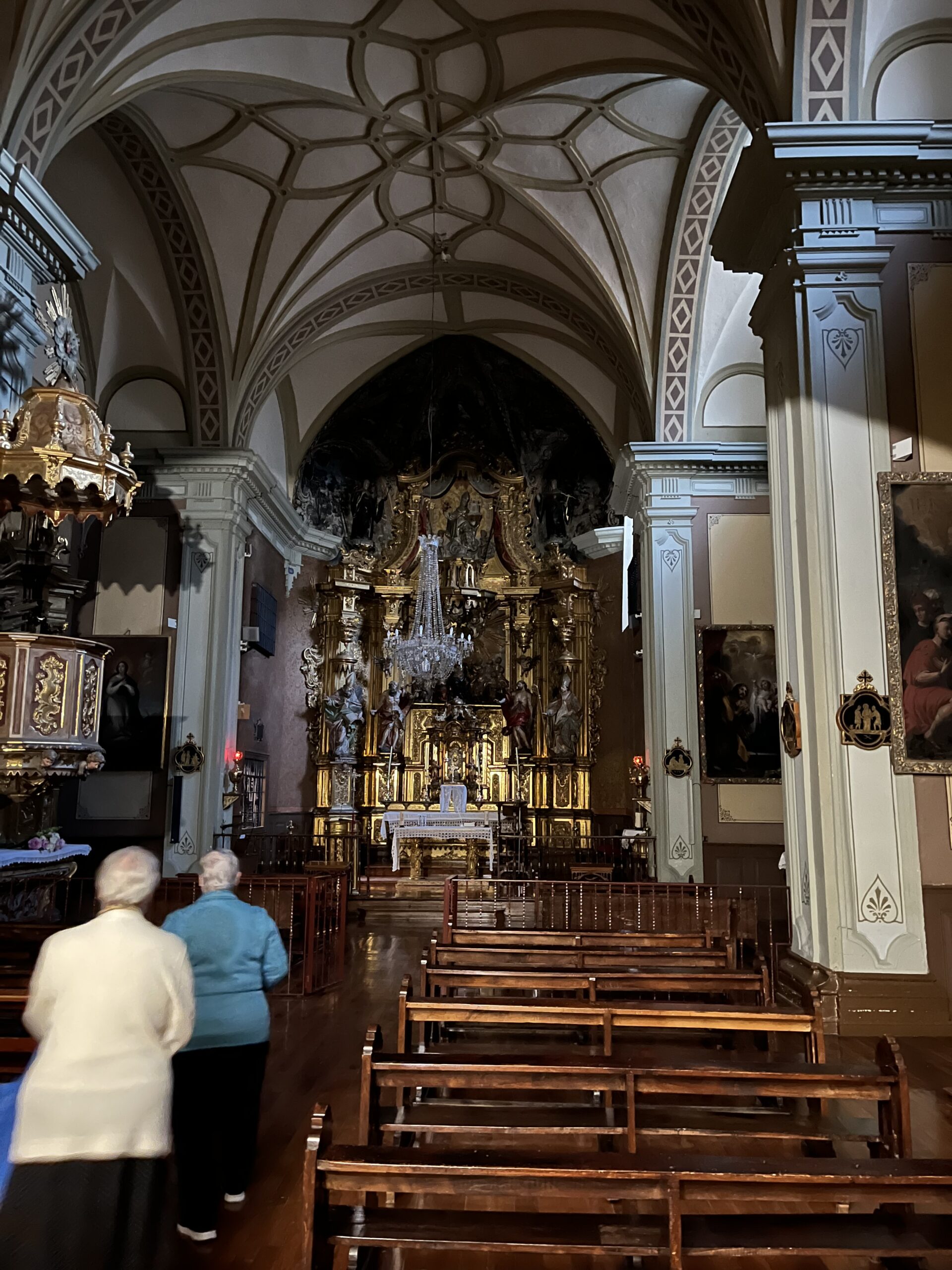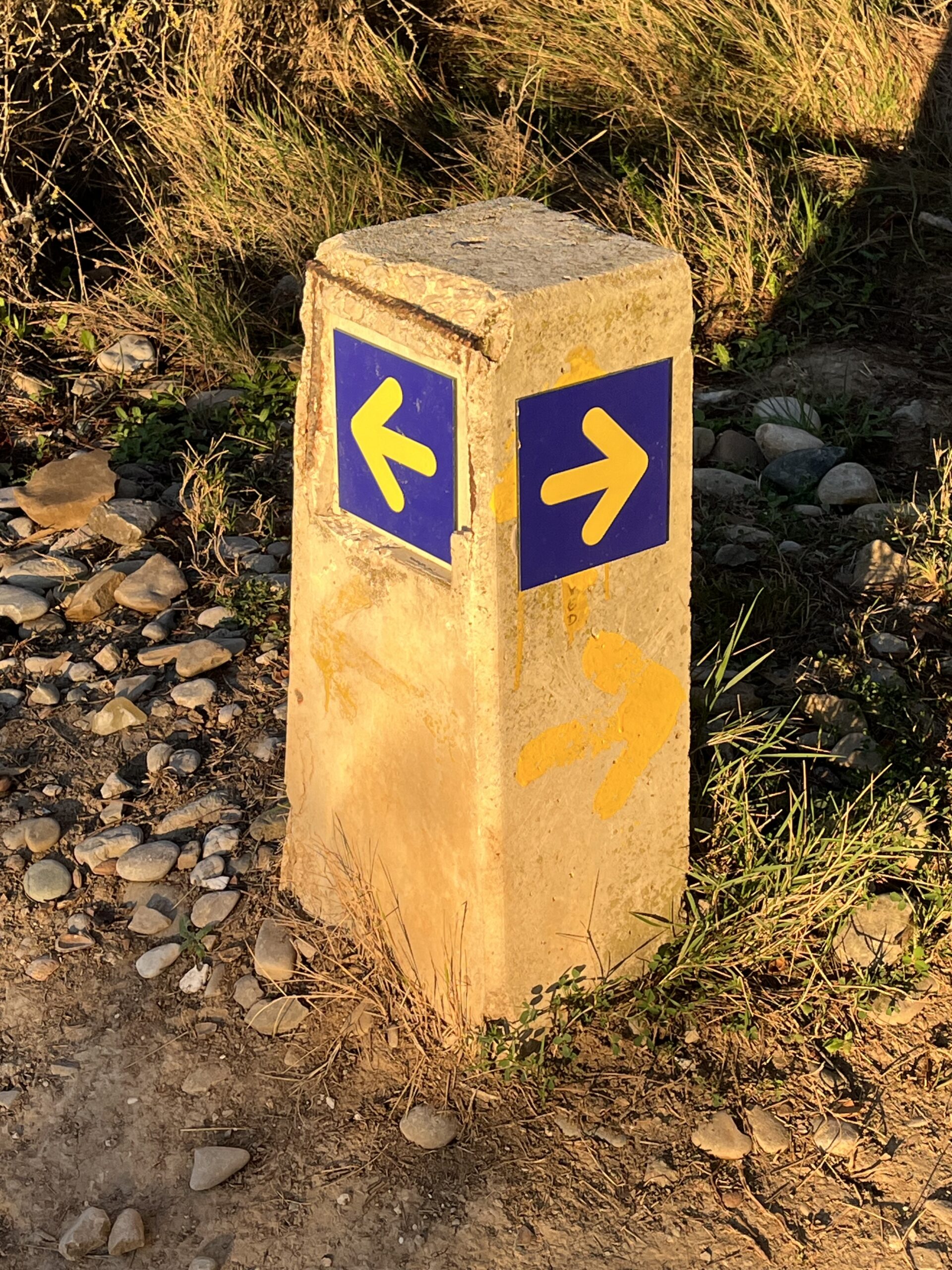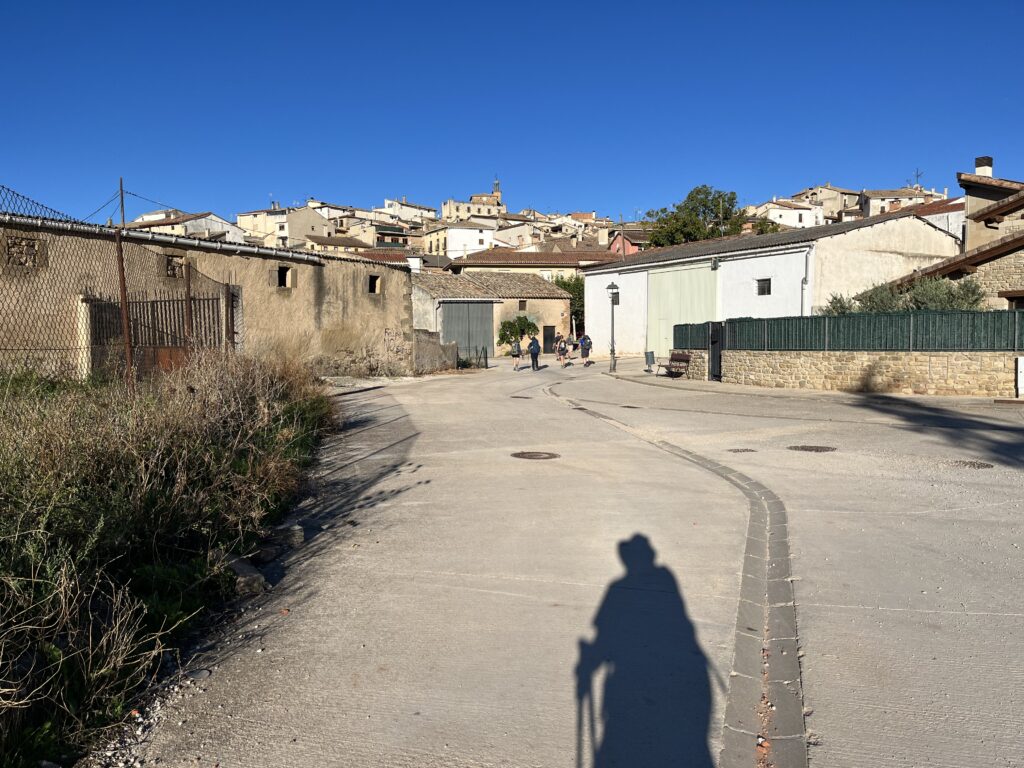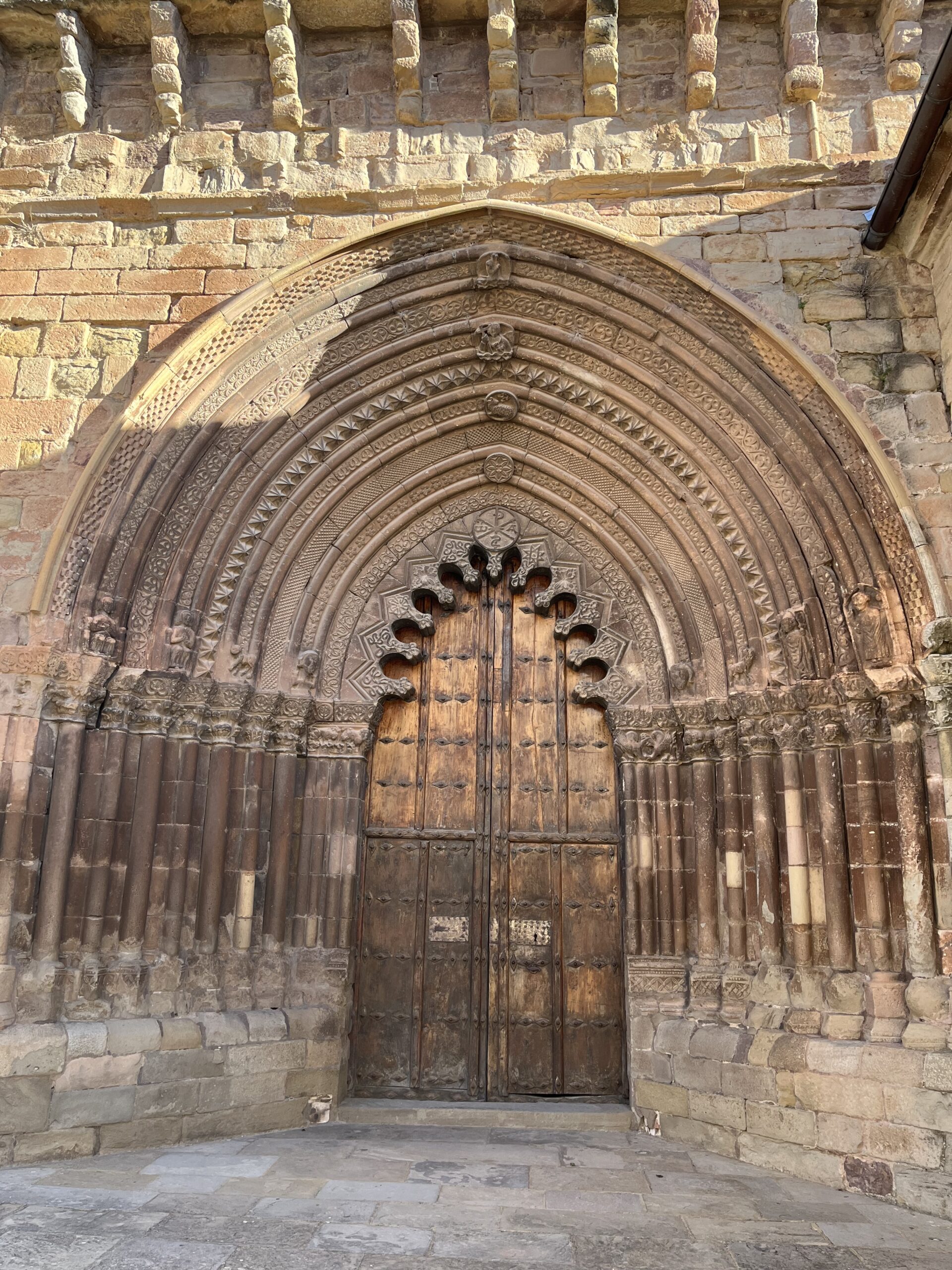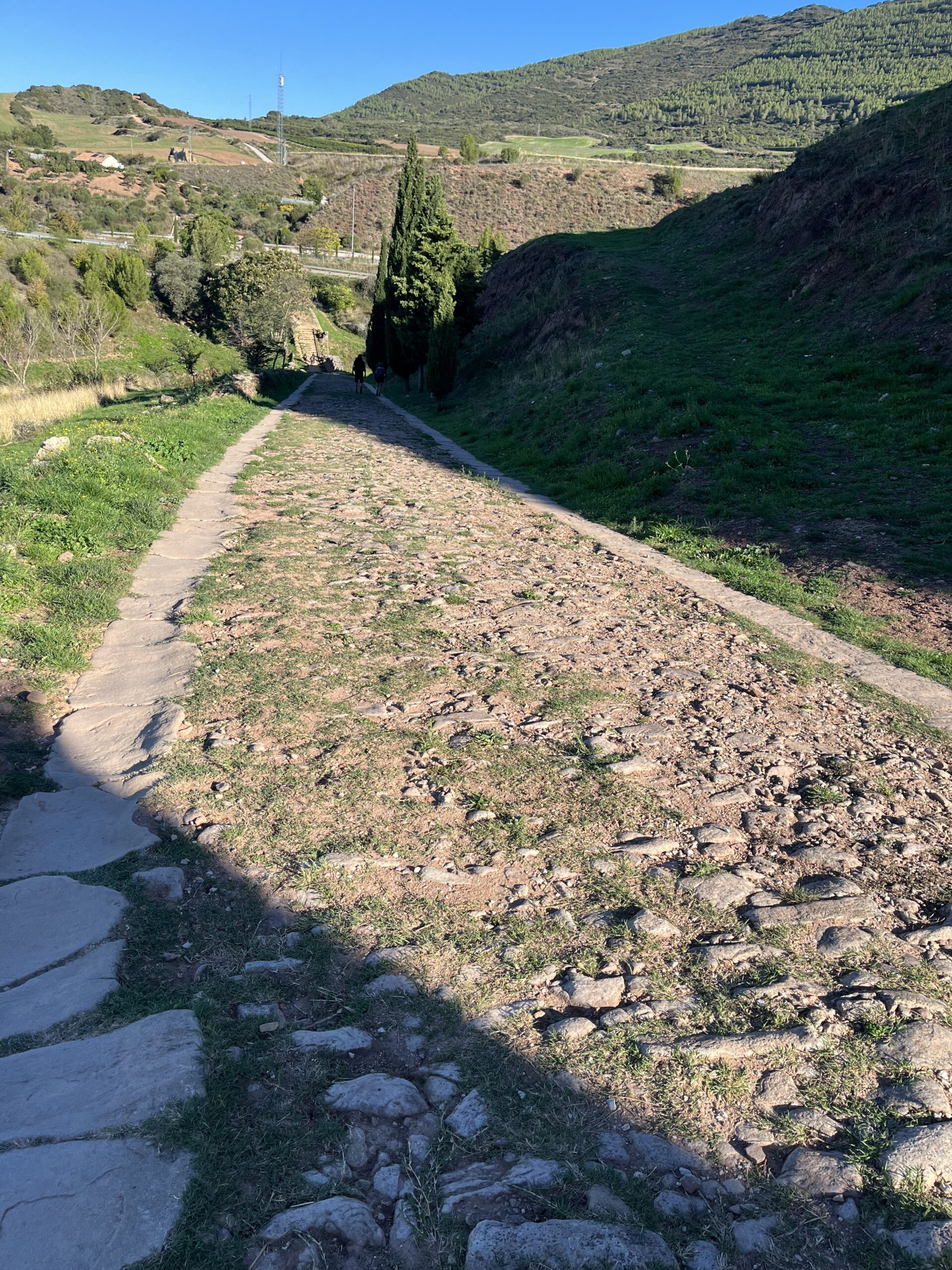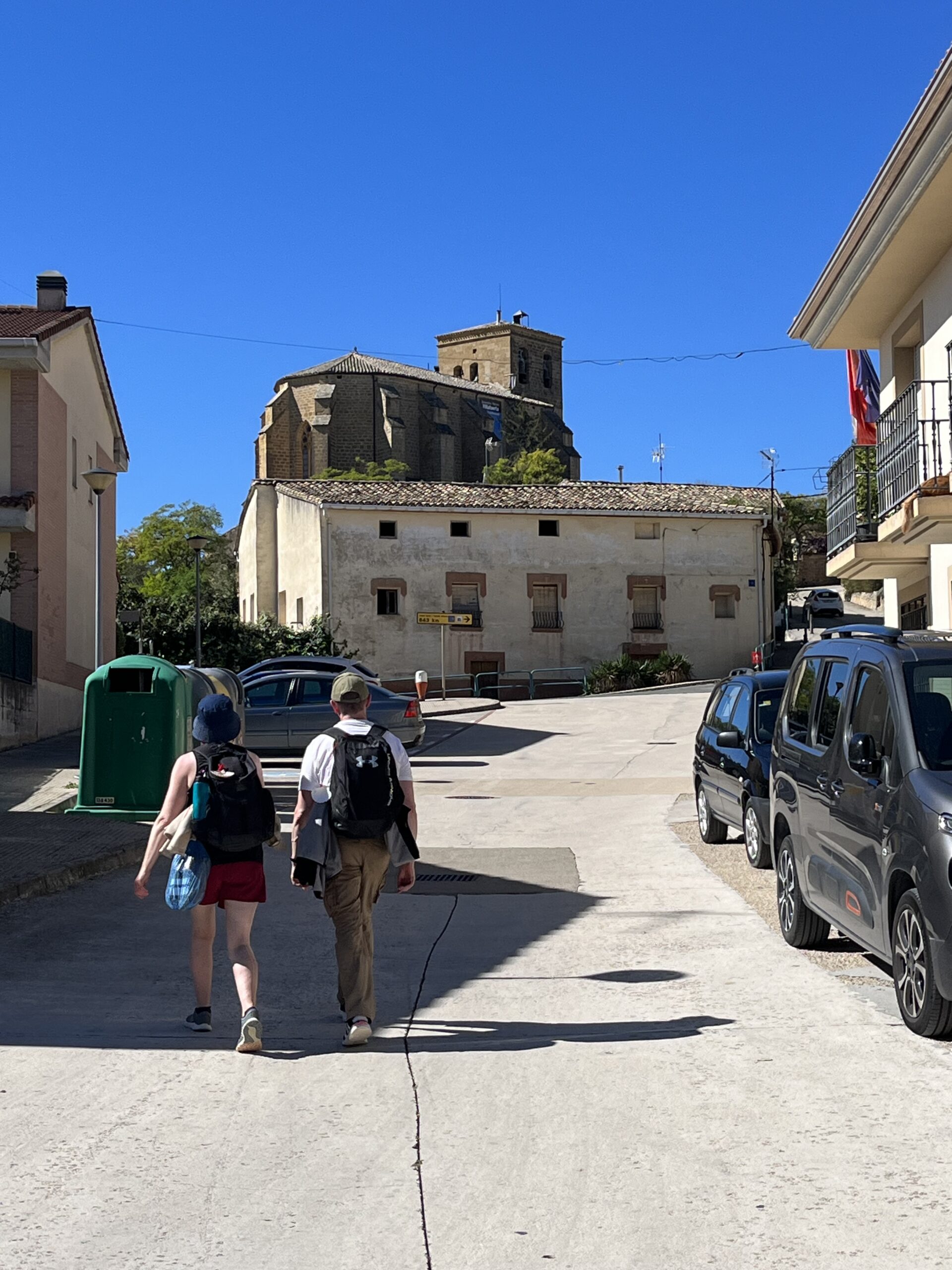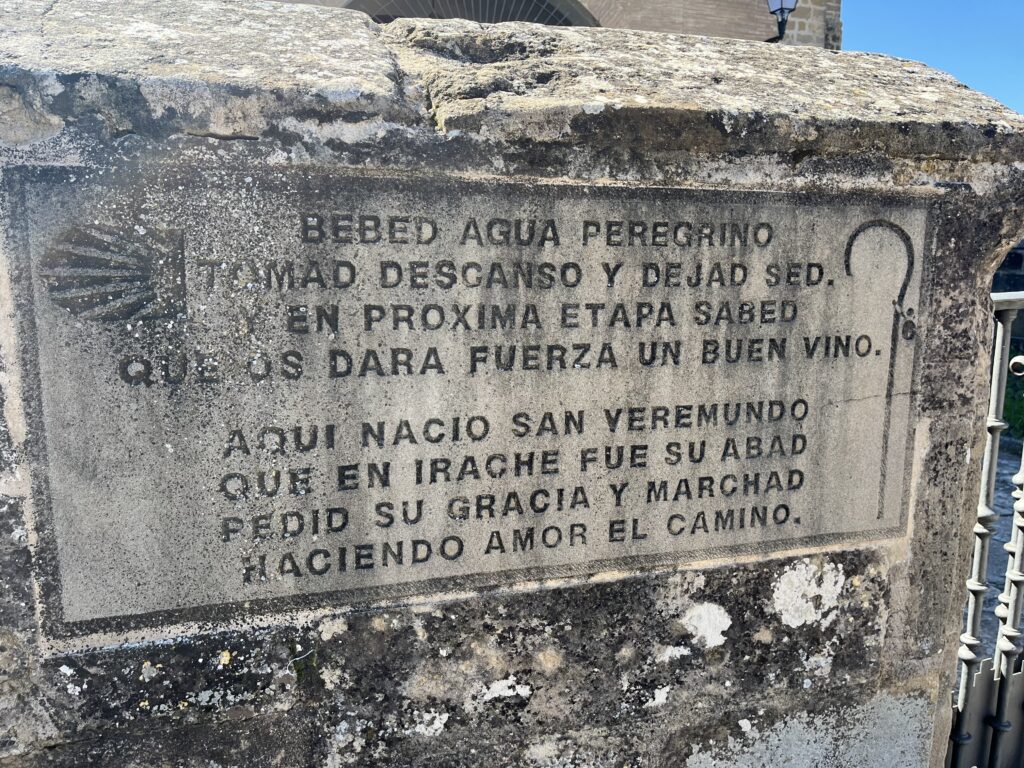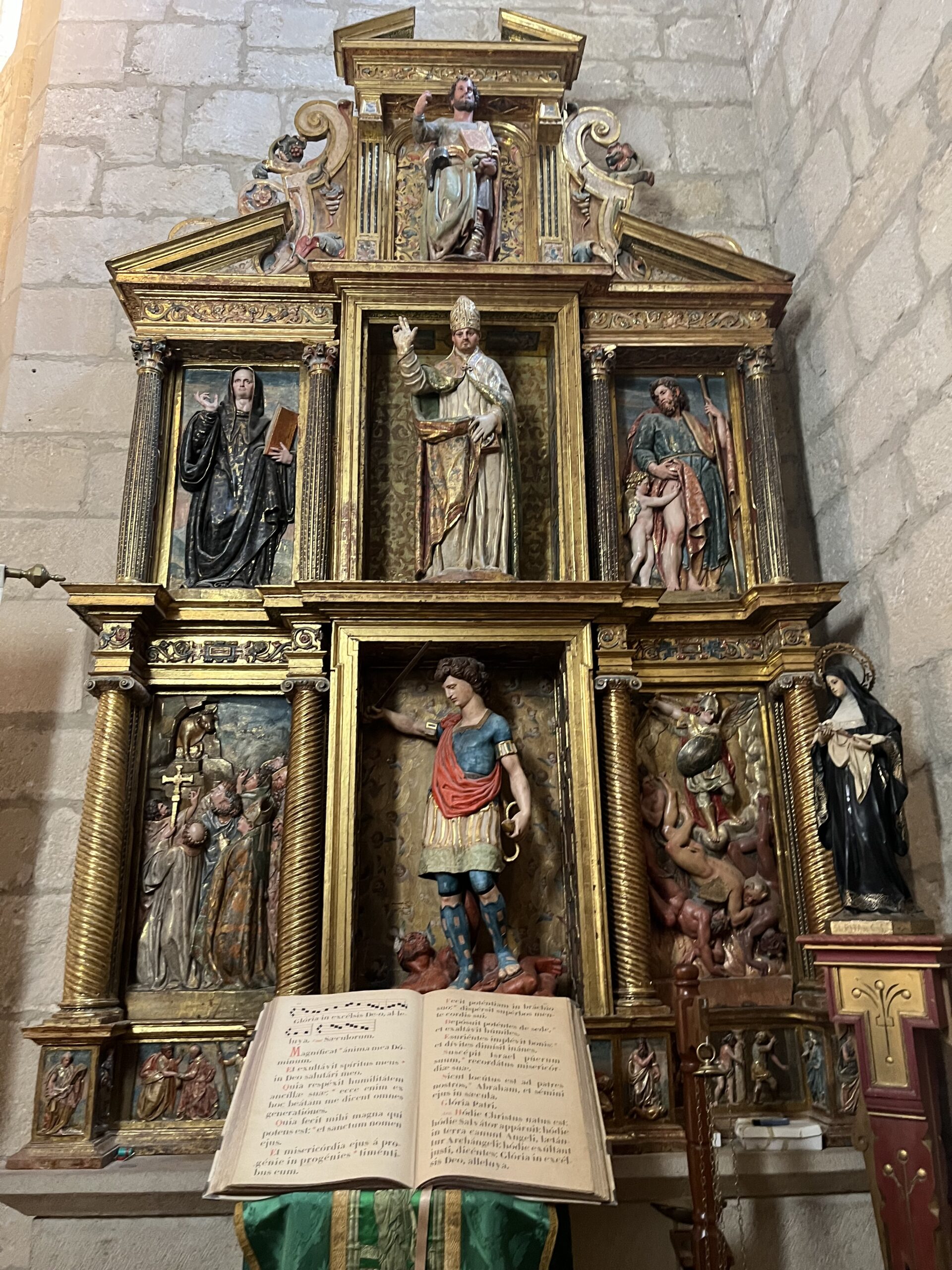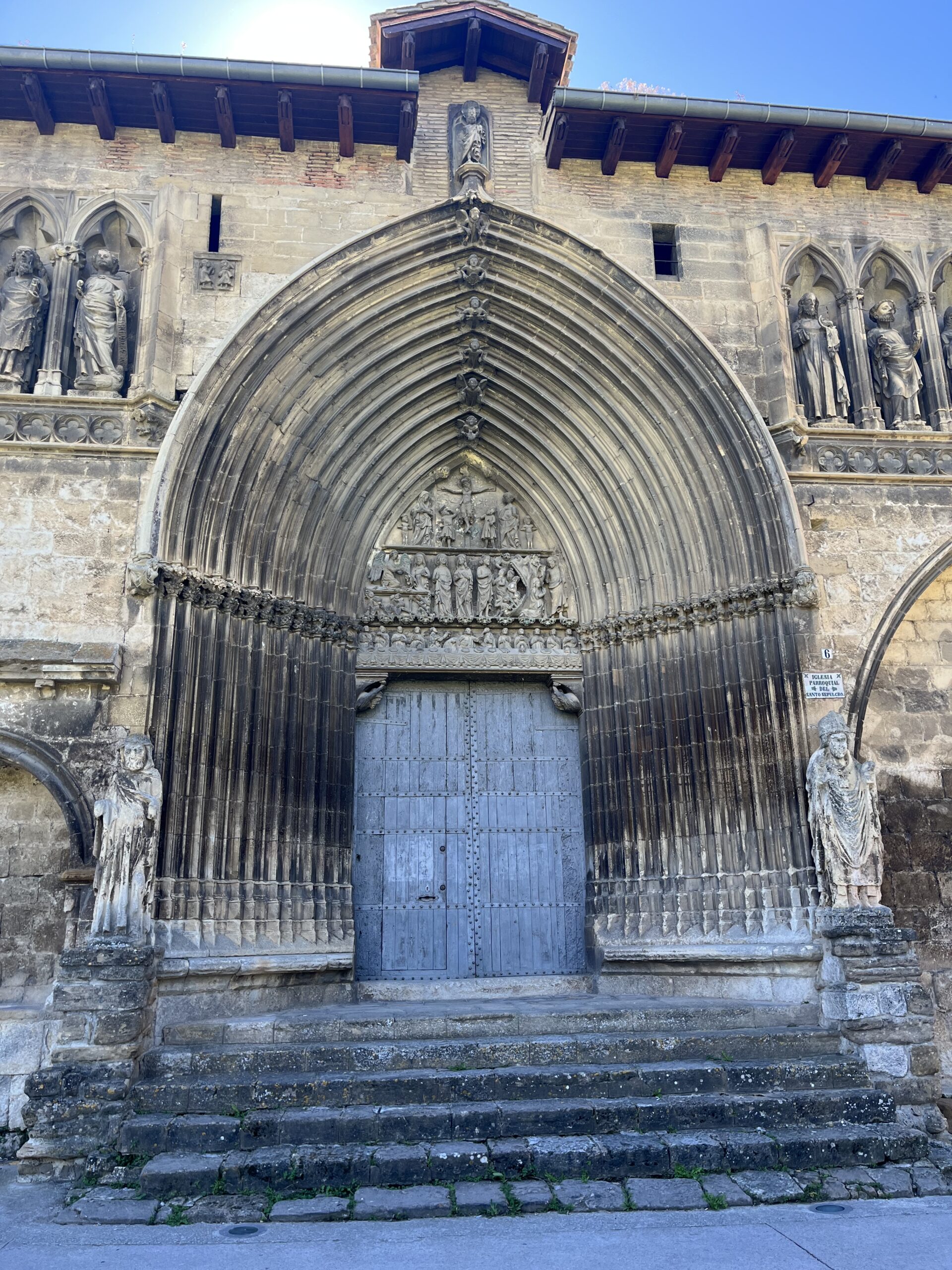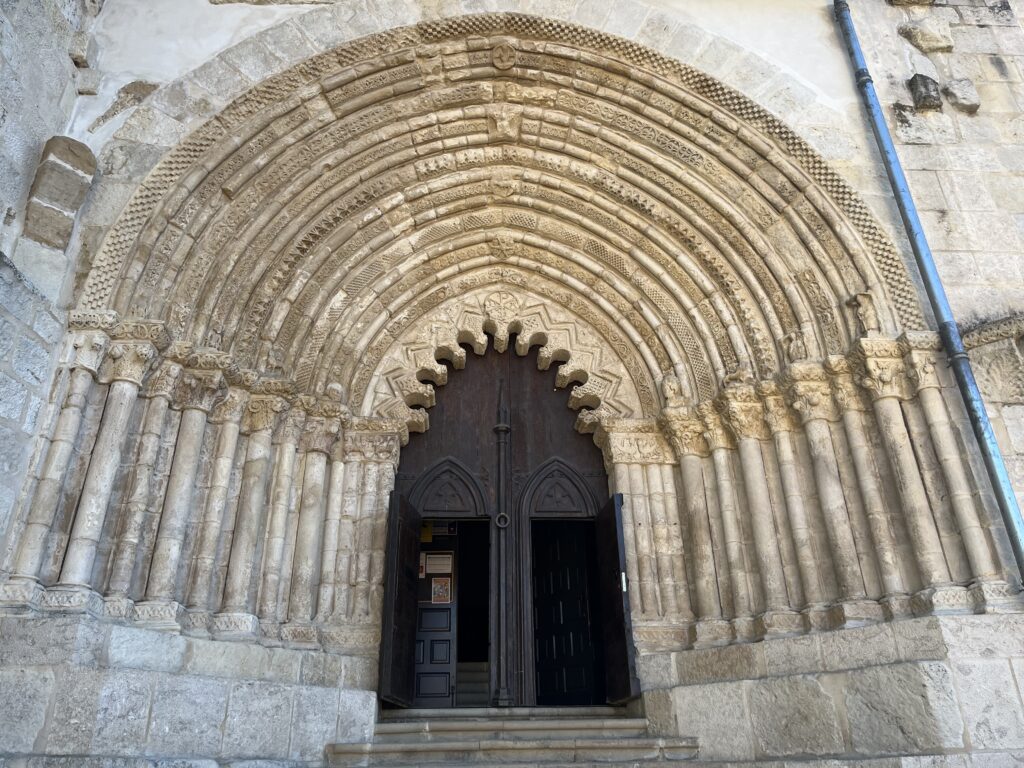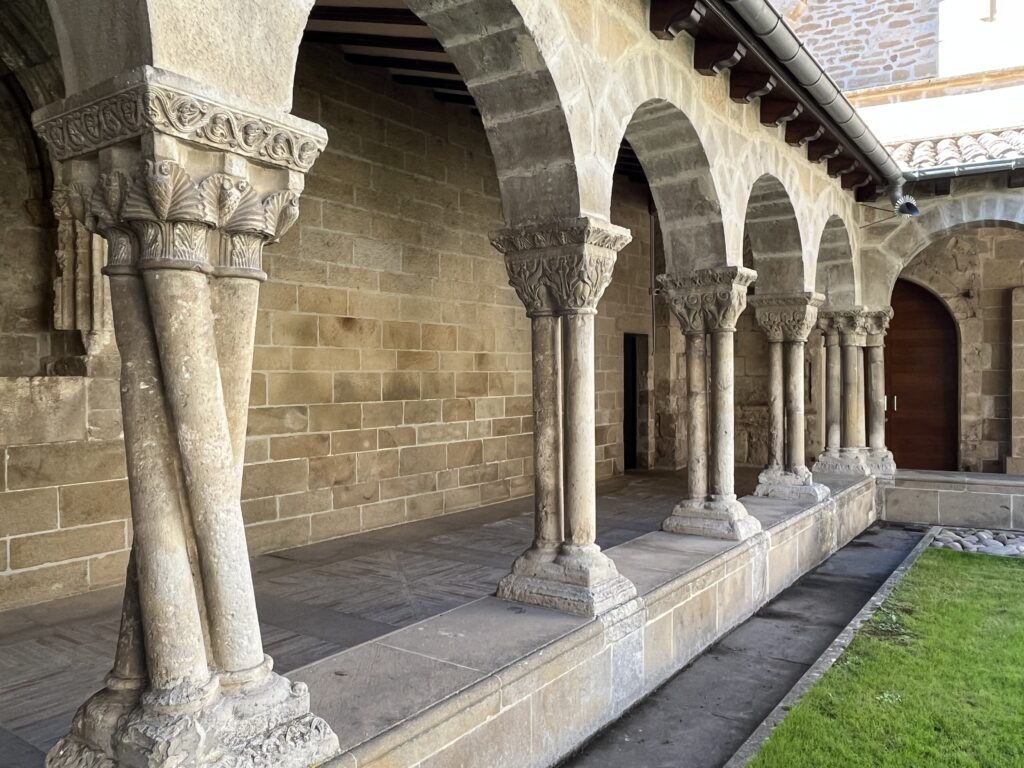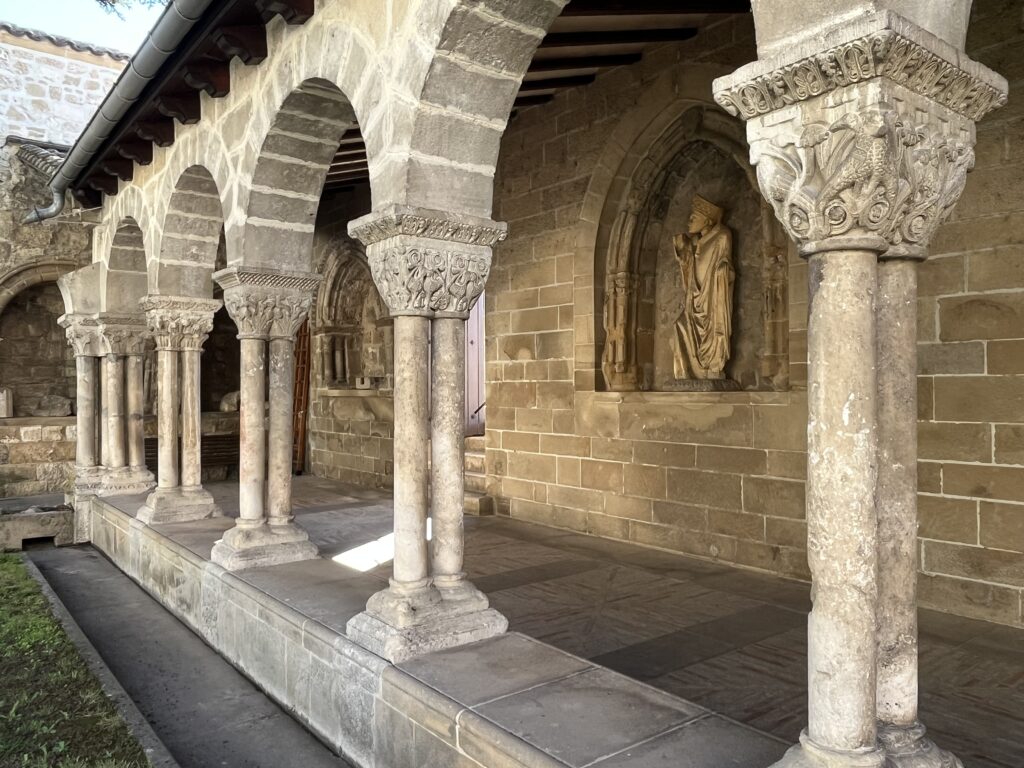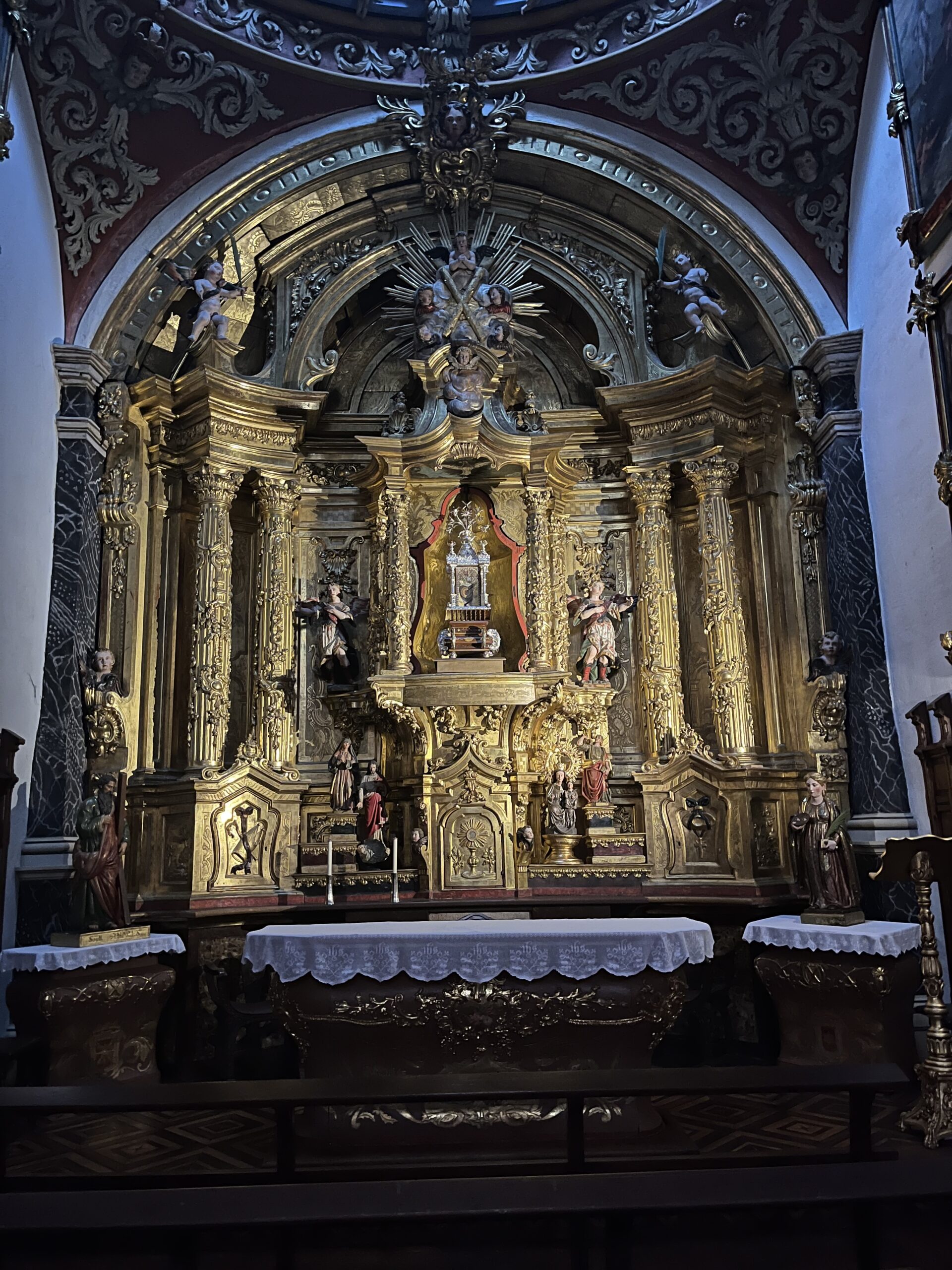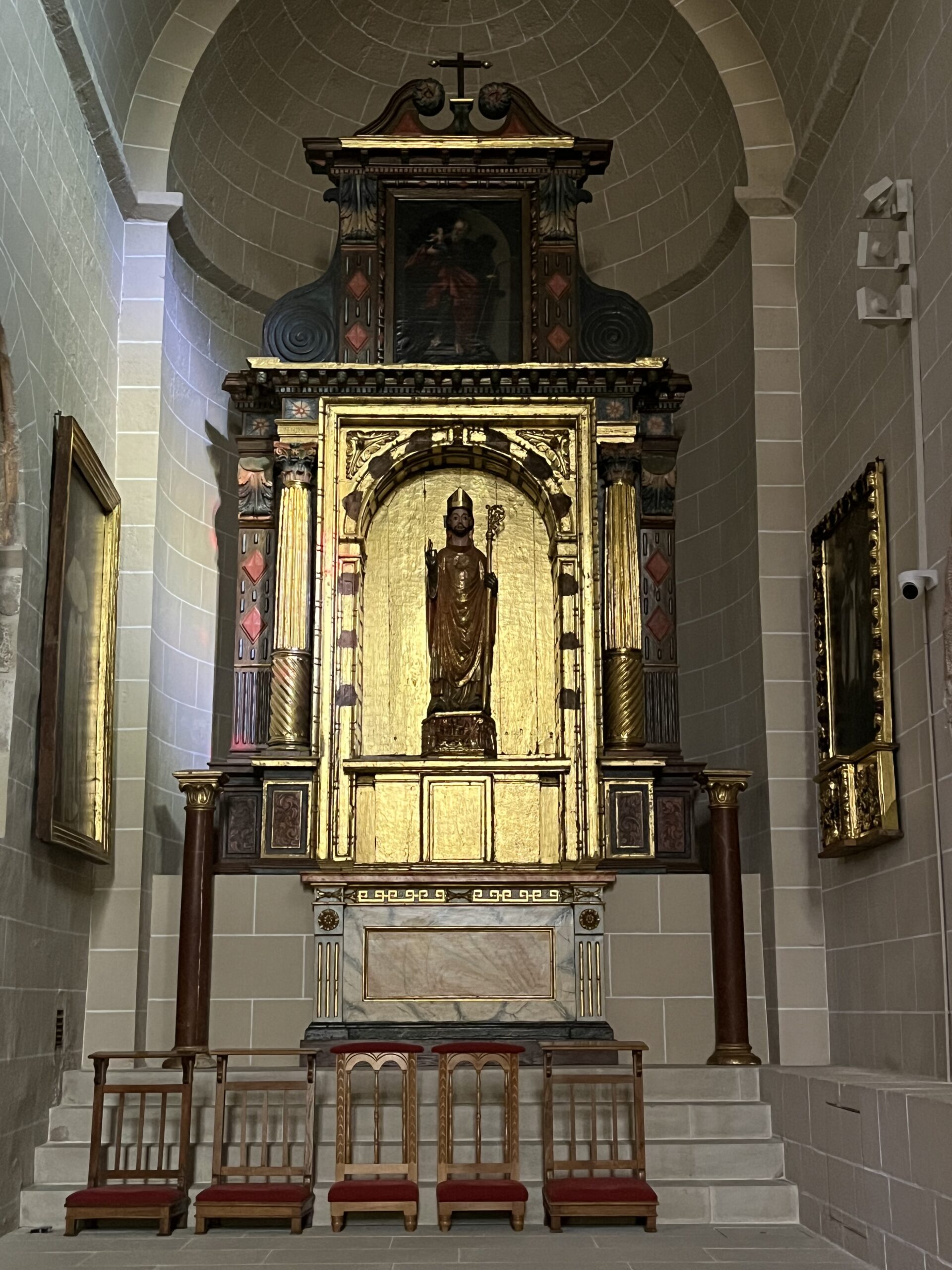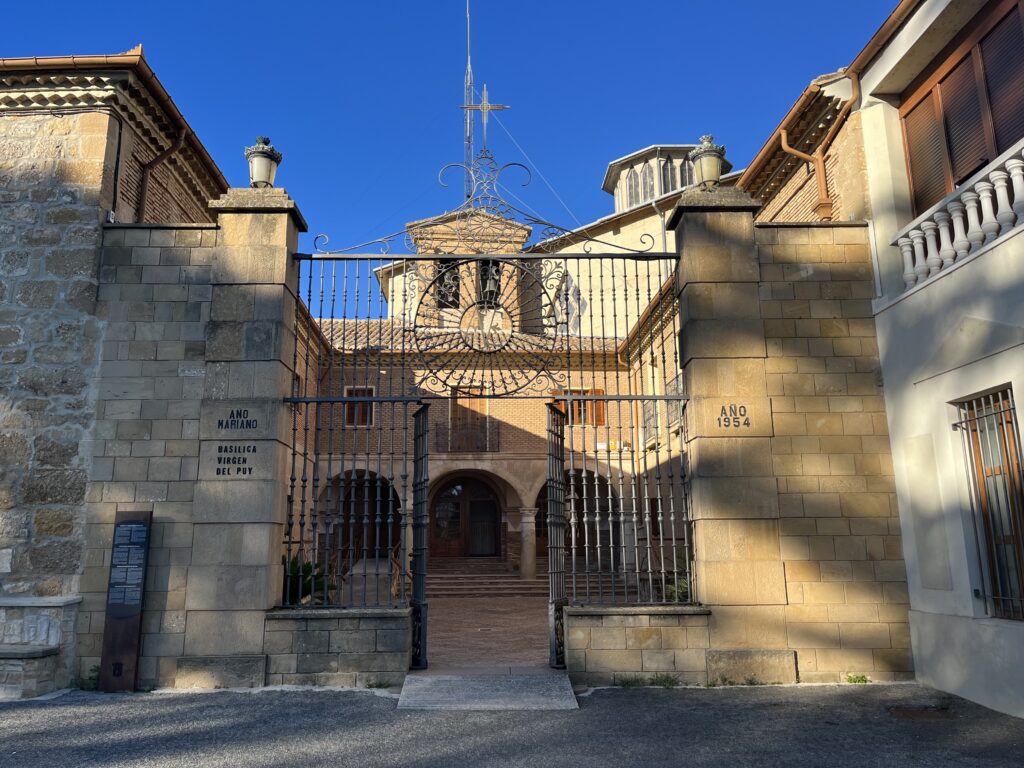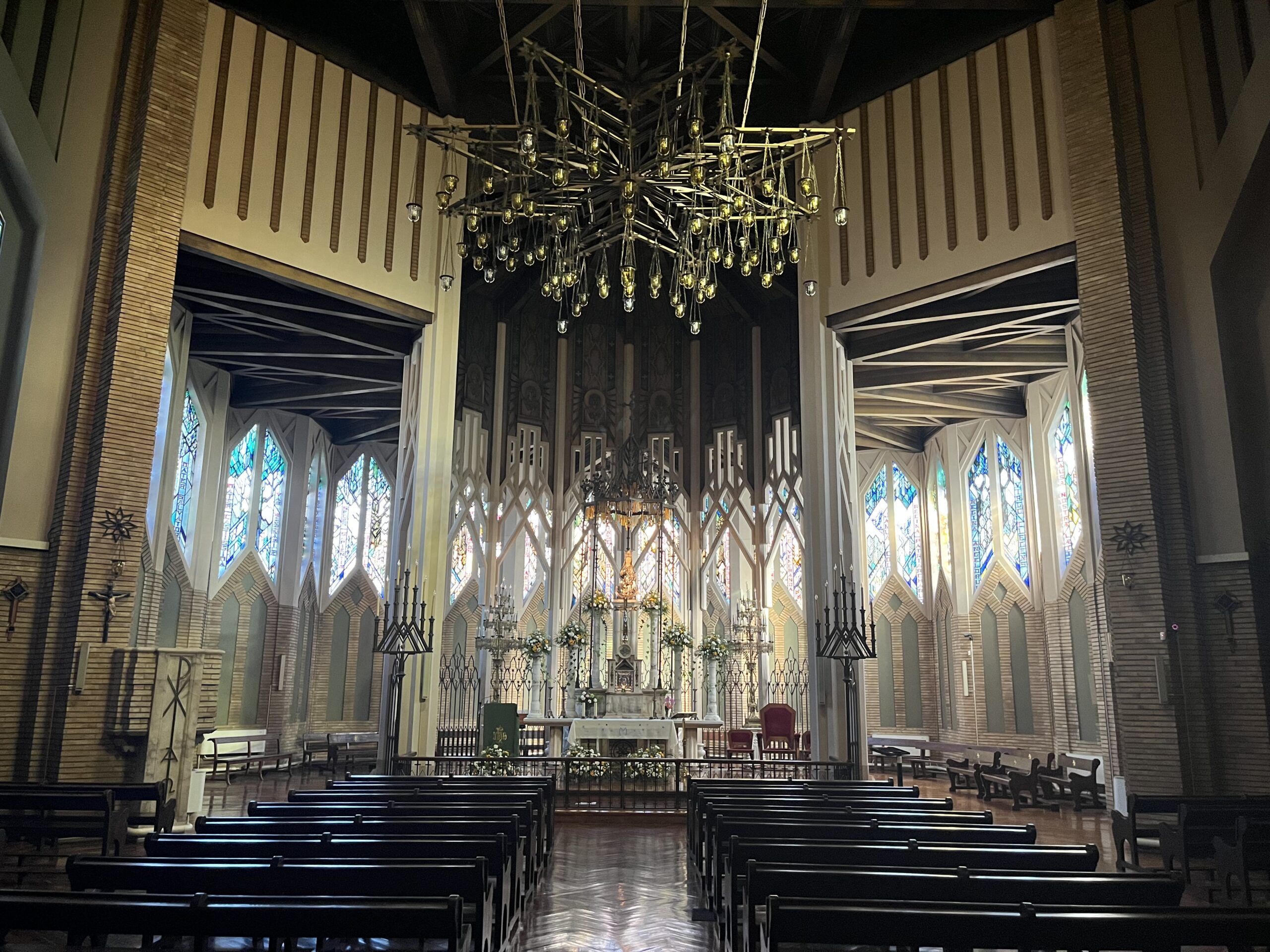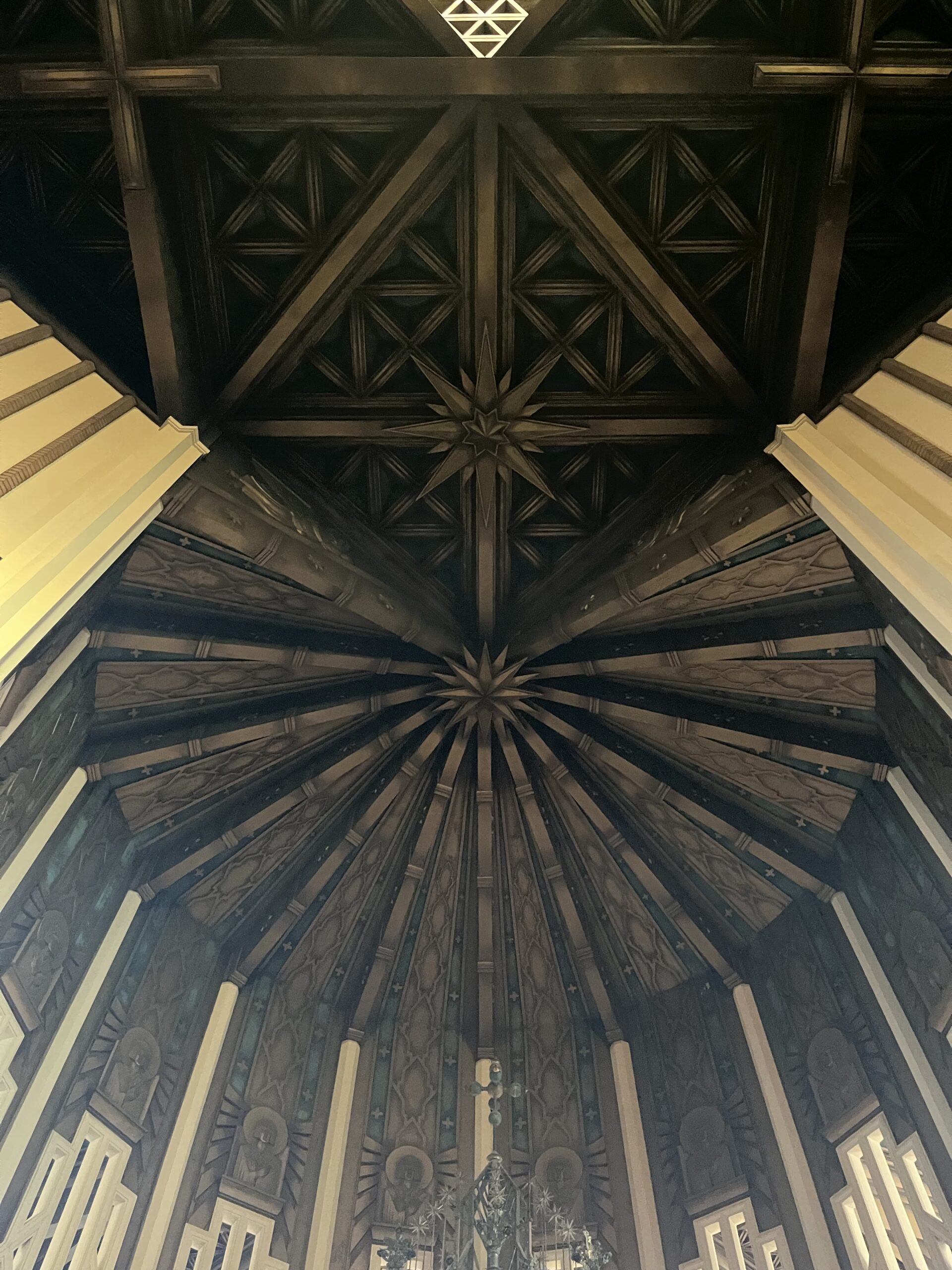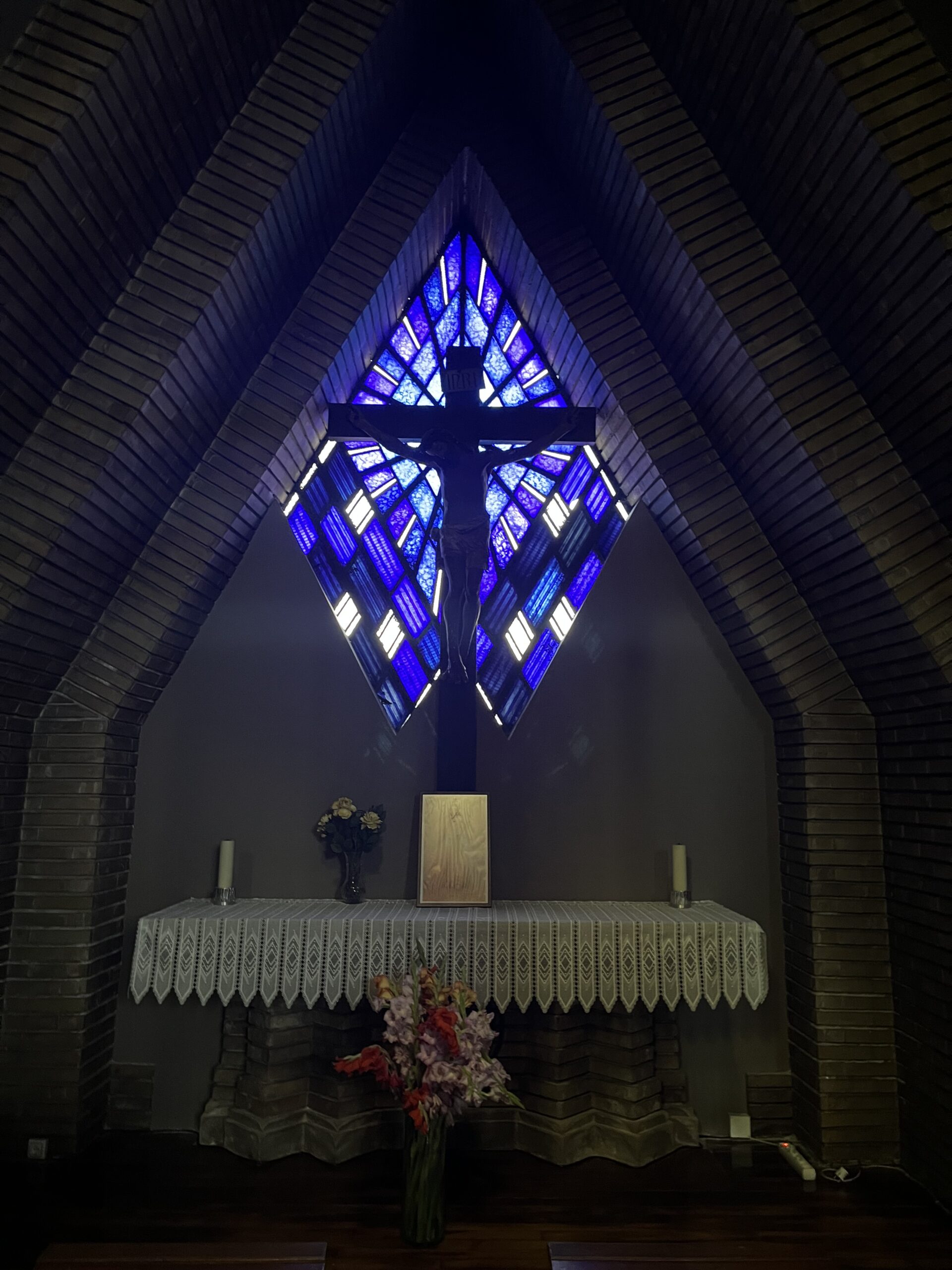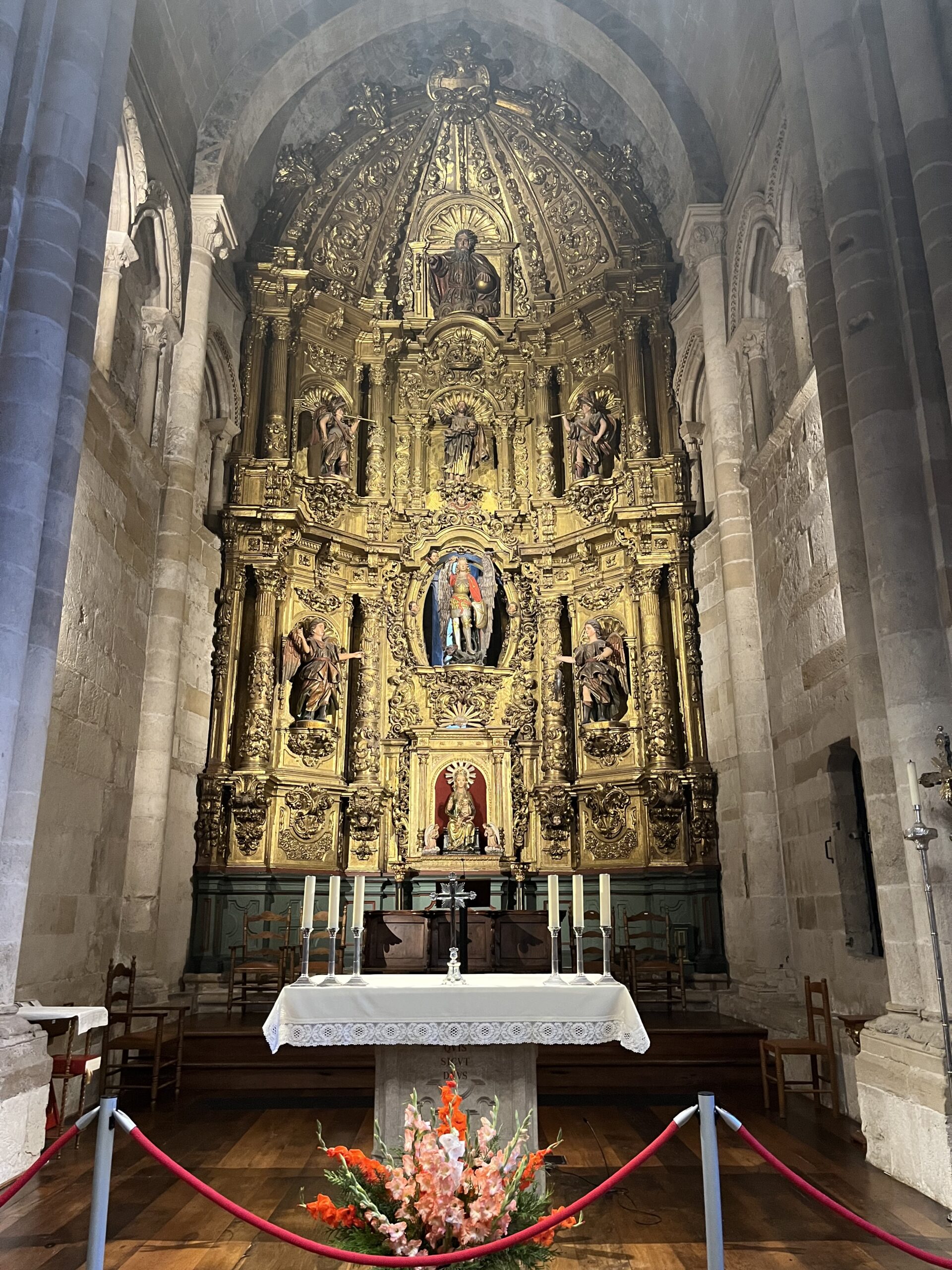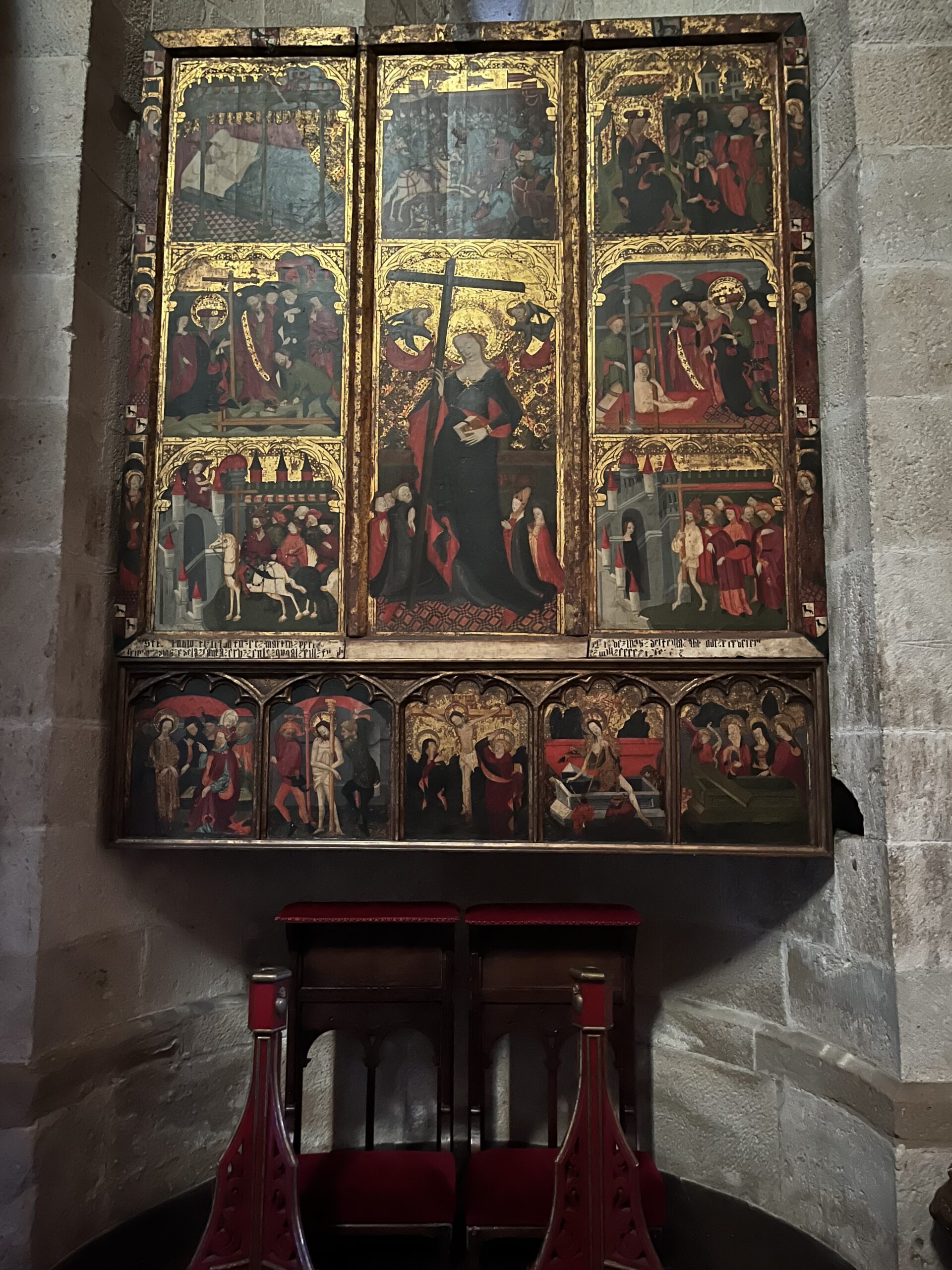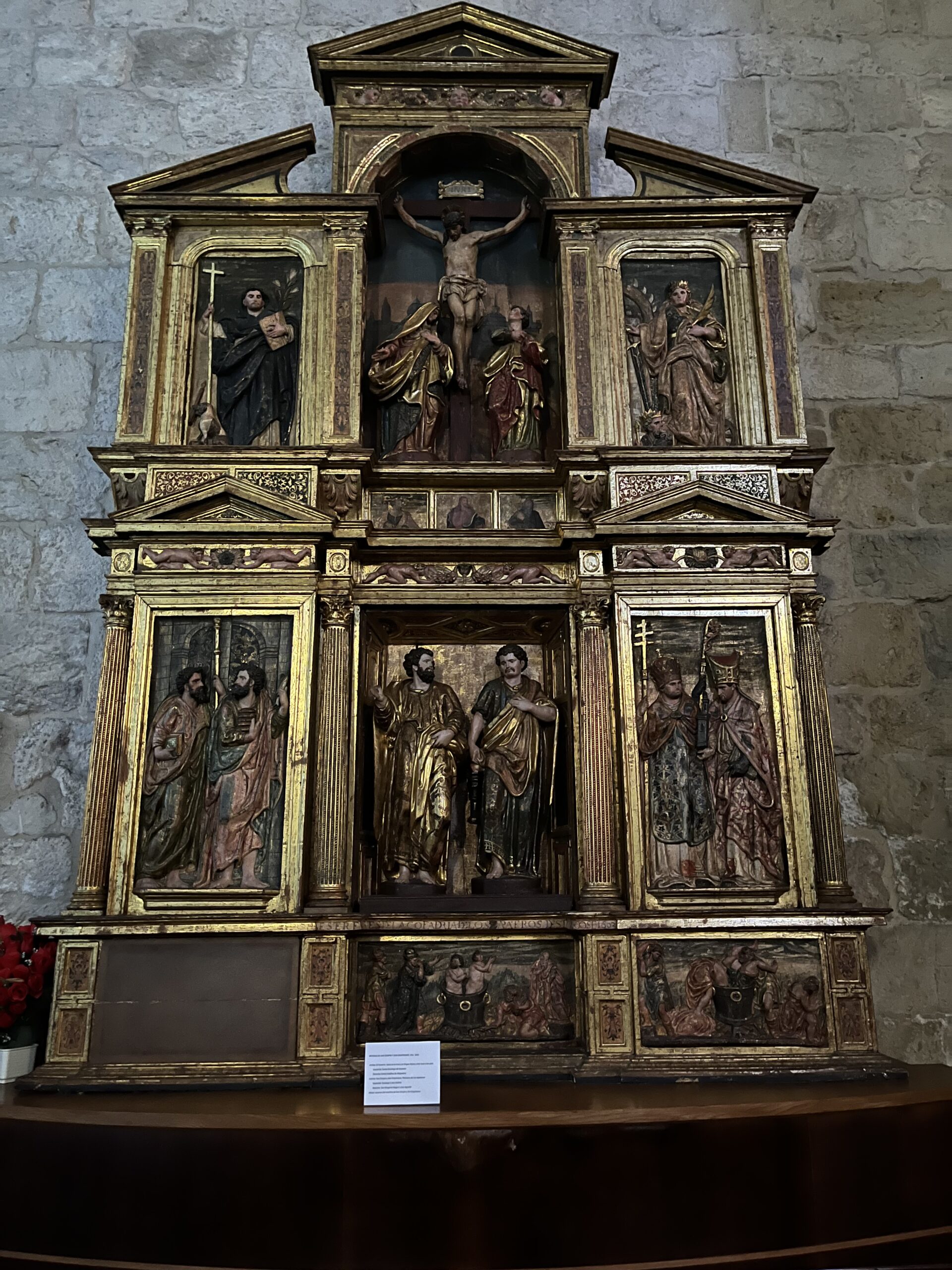Via Podiensis: Stellar Estella
Apparently my body, knowing that today was going to be a short day, slightly overslept. I mean, I was up at 5 AM with a jolt, but I immediately fell back to sleep.
Even so, I was packed and ready to go at just before 7:30 AM. Despite the lateness, I hadn’t actually slept very well. The most uncomfortable bed! My upper back was bothering me a bit. Fortunately, when I had the pack on it wasn’t as bad.
It was pre-dawn, and cool, but the sky was already lightening and the street lights in this medieval town are pretty good. I stopped for my usual breakfast, but Tara pushed on. Our little group is now well and truly dispersed. This is the first time I will be setting out alone since Saint-Jean.
I met Annika from Amsterdam on the way out of town. We talked a little bit; she’s taking a rest stay here because of possible tendinitis. It’s possible she will catch up to me when I take my rest day in Burgos, but it’s unlikely. We said goodbye. I didn’t manage to make it out of town until 8 o’clock. Now I really was running late.
I left Puente la Reina over the old Romanesque bridge for which of the town is named. There has been an argument for centuries over which Spanish queen commissioned the bridge, the name of which of course means “Bridge of the queen”. However, the earliest records we have of the bridge indicate that the central arch used to contain an image of the Blessed Virgin Mary. So, I think that’s your obvious answer.
Just across the river, I made a short visit to the church and convent of the Holy Spirit. Two lovely little old Spanish ladies let me into the church, which at first I thought was locked. Turns out you just need to jiggle the door handle in the proper way. This is another Baroque masterpiece. After the customary prayers for the intentions of the Camino, I was quickly on my way.
After this, the Camino left the main road and followed up a much easier to walk gravel road. I was clearly still in the city, but much of the noise and visuals were screened out by a row of trees on one side and a wall on the other.
After perhaps a kilometer, it turned to scrub and trees on both sides of the gravel road.
Symptoms and Root Causes
(feel free to skip this bit)
This morning I also had to finally confront a problem that had been dogging me, probably since the Pyrenees. I have, at this point, lost so much weight that I can’t get my pack to sit properly on my hips unless I am wearing my thick fleece. This isn’t too terrible a problem in the early mornings, when it is quite cool here, but as the day wears on and I have to remove my fleece, it’s getting more and more difficult to carry the pack properly. I’ve actually developed bruises and a sore on my hips because I’ve had to cinch the pack so tight.
Yesterday I tried tying the fleece around my waist, and that helped a little bit. There was some experimentation with variations on this as this morning wore on.
I had expected to lose a little weight, of course, but I think I lost too much. I think that the root cause is my calorie intake is not what it ought to be, and I’m taking steps to correct that, but in the meantime I’ll have to deal with treating the symptoms.
I always think it’s important to treat the symptoms and the cause simultaneously, rather than preferring one to the other. But that’s just me.
Back to our story in progress…
The gravel road was now paralleling the river over which I had previously crossed on the Puente la Reina.
I eventually moved away from the river, and the sun behind me cast long shadows of my body ahead of me on the road. It was as if my shadow ahead of me was urging me forward.
Eventually, under the shadow of sheer cliffs, the Camino struck out into the forest and eventually quite steeply uphill. In fact, the hill culminated in a short stretch of the steepest hillside I’ve had to climb since early days in France. I was a sweaty mess by the time I got to the top. The dread decision to take off the fleece could now no longer be put off.
The gravel road continued parallel to a pretty major highway for a stretch.
I entered the village of Mañeru at about 8:50 AM. I contemplated second breakfast, but instead ate a snack bar out of my stash. The sky was completely without clouds, and I had a feeling the day was going to warm up a lot faster than the forecasted indicated.
I ran into Stefanie while I was filling my water bottles and we had a brief chat. I then went up to visit the great domed 18th century church of San Pedro, which supposedly had some interesting reliquaries and statues. Unfortunately, it was closed. I prayed outside the doors and moved on.
After the village, the Camino moved out into open farmland on an asphalt road.
I passed a group of English-speaking pilgrims who were carrying nothing but light day packs. One of them had glitter in her hair. When I was perhaps three or four meters ahead of them they started mocking the socks that I had hanging from my pack, drying. I actually laughed out loud.
I rounded a corner, and suddenly in the distance I could see the beautiful hilltop town of Cirauqui, glittering like a million faceted gem set in the greens and browns of the hills. I always like it when you can see your next destination. It makes it easier to mark your progress towards your goal. Even if that goal is only 3 km away.
The path was now a broad and flat gravel road that wound around the little hills past newly tilled fields and vineyards with vines heavy with grapes.
Once in the town, the Camino wound its way up through narrow streets and under archways. I somehow made it all the way to the other side of town without passing any churches. I knew that couldn’t be right, so I doubled back and then climbed some stairs to the church of San Roman. It was, predictably, locked. It has been worth it, though, to see the magnificent archivolt over the main entrance. Very unusual, with I suspect, a Mudéjar influence.
Had a coffee, and somehow didn’t leave until 10 AM. Yikes! I was definitely running behind my normal pace and rhythm of the day.
After the village, the Camino continued on what you might think is a random collection of cobblestones, but it is in fact the longest stretch of existing Roman Road on the Camino. They haven’t re-paved in more than 1600 years, so it’s a little rough. Fortunately the wide flat-ish “pedestrian stones” on the edges are still a relatively easy walk.
The original Roman bridge over a small stream on the stretch is long gone, except for some of the pilings. The current bridge is built on this foundation, but it’s a good three meters below what had been the road surface, so there are steps down and steps back up.
The Roman Road continues on the other side, at least for a little while until it merges with a modern highway. The Camino itself passes over the highway on a bridge and then continues on a gravel road through scrubland, overlooking the highway on the hillside below.
Eventually, the Way struck out into farmland. As I was passing some grapevines, I came a food truck and who should I see there, but my old friend Philippe from the Vendée. We had a brief little catch-up. He told me that he fell again just outside Pamplona – again it was his bad knee and a misstep. He’s considering taking a rest day tomorrow, but he is looking and feeling good otherwise.
I crossed over an arched stone bridge with the rather grand name of “Puente de Dorrondoam, and then the Camino took a sharp up, the gravel road becoming a dirt path.
Just before 10:30 I passed a shady grove with what appeared to be an abandoned garden/café/library. Quite charming, but it looks as though it hasn’t been in use in some time. It’s a shame. It’s exactly the sort of spot I would’ve stopped for a while.
The Camino, meanwhile, continued downhill and uphill over a variety of surfaces including, memorably, a big jumble of stones that slow progress quite a bit. Fortunately, this only lasted a short while, and it was back to dirt and gravel walking for the most part.
Although there was plenty of plant life, this was mostly in the form of little scrub plants and taller bushes. There was very little shade.
At one point, the Camino passed under the freeway. The walls of the little tunnel at some of the more spectacular graffiti I’ve seen so far. The Camino soon began to parallel a road, and the second time I crossed under the same freeway less than a kilometer later, the graffiti wasn’t nearly as interesting.
About 10:55 AM, I passed under a modern aqueduct that never fails to impress me, the Canal de Alloz. Sure, it’s not as pretty as the ones the Romans built, but it definitely has a distinctive style of its own.
Afterwards, the Camino left the roadside once more for the scrub country. I was considering putting up the umbrella, but the Camino quickly turned underneath tree cover for a stretch, a much needed relief.
Once again, the Camino passed under the freeway, this time through a magnificent arched stone tunnel. I emerged blinking into bright sunlight. The umbrella came out.
A stony uphill climb brought me into the village of Lorca at about 11:15 AM. I had hoped to visit the 12th century church of San Salvador, but it was locked. Nevertheless, I prayed outside and continued.
After this, it was a roadwalking or next to the road walking for a while.
Boy howdy, there’s nothing quite like the smell of a freshly manured field baking in the sun.
About 11:40, the Camino left the side of the highway for good and struck out across open fields. Just a few minutes later, I could already see today’s destination, the city of Estella, in the distance. My plan was to stop in the village a couple of kilometers before the city for lunch and to think about where I might want to stay in the city.
As I passed a group of American and Scottish pilgrims, one of them asked about Dobbles, and we had a short conversation. I know this only because this is the third time today someone has asked about my little penguin mascot. By way of contrast, I was asked about him three times in the entirety of France.
On my way into Villatuerta, the Camino once more passed under the freeway through a a stone archway. Once I finally entered the village proper, it was more upper class suburbia than village.
I stopped for lunch at a little streetside café. Saw Tara briefly, but she was just finishing up her lunch, and so moved on.
As I was finishing up, up rolled Stefanie from Newfoundland with Luciano from Brazil (and Alberta). I walked and talked with them into the city. On the way, we stopped in Villatuerta’s 14th century church of La Asunción to visit and pray. The tiny interior is beautiful, and it was the pastor himself who was stamping the pilgrim passports there. It was the first stamp of my second credential. The church contains the relics of a local saint, San Veremundo.
Later, we ducked into the 10th century Hermitage of San Miguel. There’s not much to the interior, as any ornamentation has long since been stripped out. I do find it very moving, however, that passing pilgrims have left papers and other objects with prayers, requests, and exhortation’s to their fellow pilgrims.
And then, finally into the city of Estella! On the way into town, we checked out the Iglesia del Santo Sepulcro. Closed, of course, but an amazing sculptural study on the outside, particularly the entrance where the threefold tympanum has the Crucifixion, the harrowing of Hell, and the last supper all represented.
I checked into the municipal albergue and did the usual showering and laundry routine. Then I had a late second lunch with Stefanie before going out to explore the town.
First on my list was in the church of Santa María Jus del Castillo, which was built near the end of the 12th century on the site of a much earlier synagogue. The entrance was completely redone in the 18th century unfortunately. It was also locked.
Then, I headed across town to the church of San Pedro. It’s built into the side of the hill, so there are long stories of steps to reach the entrance. Much like the church in Cirauqui today, the archivolt is magnificent and shows Mudéjar influence.
The sacristan (or whoever) let a couple of us into the cloister of San Pedro. I don’t think I’ve ever been here, and it’s kind of amazing – Romanesque goodness!
The church itself is a mishmash of Romanesque, Gothic, and later Baroque and mannerist styles. It’s basically three naves, including two side chapels in line with the sanctuary and a third at a right angle. The building was clearly designed to fit the space for it available on the side of the hill.
Despite the chaos of conflicting styles, the architecture really does bring the building together into a somewhat coherent whole. Certainly, it is a very fruitful place to pray, and I prayed Vespers here with the intentions of the Camino.
The brilliantly Baroque right angle side chapel, which is located under the church dome, contains a relic of Saint Andrew, a chip of bone from his shoulder. Reportedly, a pilgrim in the late 13th century died near here, and when his belongings were examined it was discovered that he was an incognito eastern orthodox bishop on pilgrimage to Santiago and carrying the relic.
Then it was time to visit the Basilica Nuestra Señora del Puy – the Basilica of Our Lady of Le Puy. This involve a long climb up countless steps of the hillside, passed a Catholic school dedicated to her, and also a nearby Benedictine monastery.
The current building, constructed in the 20th century, replaces a long series of of churches dedicated to the Virgin of Le Puy on the site going back to at least the 12th century.
The sign outside called the interior “neo Gothic”, but this is unlike any Gothic I have ever seen. If I had to name a style, I would say it is a cross between Gothic and Art Deco. In place of the rounded, pointed arches associated with Gothic we have sharp and precise angles with not a curve in sight. Like Gothic, it is full of windows that fill the place with a color and light, as well as the delicate stone tracery you see in places like the cathedral in Condom. But again, there is not a curve anywhere in the architecture.
The place is startling, and it stopped me in my tracks when I opened the door. But it is beautiful. I prayed here, and sat a while lost in thought.
I came back down the hill and visited the last church on my agenda, the late Romanesque / early Gothic masterpiece of San Miguel.
While the interior altars are all Baroque, the bones of this place are solid 13th century. It’s one of those places where you can just feel the weight of centuries and the generations of the faithful who here sang the praises of almighty God.
Date: 25 September 2023
Place: Estella
Today started: Puente la Reina
Today’s Photos!


